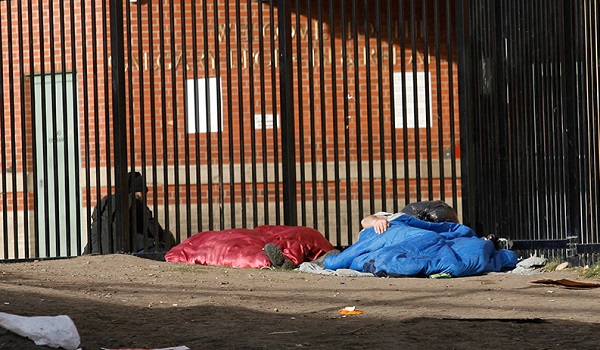Stoppage of funding temporary shelter for asylum seekers by governments has left them sleeping on sidewalks
On a recent June morning, a lineup of refugees and asylum seekers to Canada waited outside of Toronto’s Peter Street intake centre for people experiencing homelessness. With their lives in a rolling bag or backpack, they counted the hours until they could get help finding a temporary shelter. With nowhere else to go, some sat or lay on the sidewalk, a few with a strip of cardboard to soften the ground.
It’s not all that different a scene from one year earlier, when the Star reported large congregations of newcomers were sleeping on those same sidewalks, caught in the middle of a funding dispute between federal and city governments.
Since then, federal and local governments have spent millions trying to bring people off the streets, but those on the ground say their efforts have fallen short, with one prominent advocate saying they have seen an increasing number of newcomers sleeping unsheltered, with the shelter system not able to meet the spike in demand.
“We used to tell people if we didn’t have a bed, they could call (the city’s shelter) Central Intake and after a few calls find a shelter bed,” said Jacky Tuinstra Harrison, executive director of Matthew House refugee support centre. “But that hasn’t been the case for over a year now, and weekly people are sharing with us it takes them many days to secure even a respite bed.”
Asylum seekers are among hundreds of people being turned away from Toronto’s shelter system each night, city data shows, with Tuinstra Harrison saying the most recent arrival to Matthew House is a young woman from Africa who slept in the rain outside a downtown shelter because they had no room for her.
Meanwhile, a promised reception centre for newcomers near Pearson airport still has not launched, with the federal and Peel governments locked in a funding battle; and Black-led churches who took in refugees and asylum seekers who had been turned away from the city’s shelter system last summer are still shouldering much of the costs and care of newcomers.
While cities say their hands are tied until more funding flows from Ottawa, the federal government says it’s working on solutions with more money to come.
“Work and progress toward longer-term solutions” is ongoing, said Isabelle Dubois, a spokesperson for Immigration, Refugees and Citizenship Canada. She said the IRCC’s renewed funding for the Interim Housing Assistance Program, $1.1 billion for affordable housing and other programs over the next three years, “underscores our continued commitment to playing our part.”
However, Eddie Jjumba, a senior pastor at Milliken Church who is among those who helped shelter newcomers and continues to advocate for them, says little has been done to meaningfully change the system that has caused this crisis.
“Even though it’s one year now … we’ve had 10 months to really think through a solution, and we have not acted on that, at least on the side of the government,” he said. “We’re still doing reactionary things.”
City still short needed resources
Toronto Mayor Olivia Chow, who came into office in the early days of the crisis, has been vocal in her support of sheltering newcomers, often finding herself at odds with the federal government and occasionally city staff over how to fund and execute proposed measures.
Ahead of Chow’s first municipal budget, budget chief Shelley Carroll warned that a “federal impacts levy” could be included in the property tax increase if the federal government didn’t commit to millions in funding to shelter refugee claimants in Toronto. Days before the budget was unveiled, after weeks of pressure, Immigration Minister Marc Miller announced $362.4 million in new funds to support refugees across Canada, including in Toronto.
The city has seen success in some areas, such as providing reimbursements to churches and community groups from federal funding for part of their expenses in housing newcomers, as well as securing commitments for federal funding to cover ongoing shelter efforts. But those efforts haven’t met the growing demand, leaving many still turned away from city services each day.
More than 4,000 refugees and asylum seekers stay at city shelters each night — a number that has risen to nearly match the population of other people using city shelters.
Currently, Chow says the city is working with settlement services groups to figure out how to integrate existing community services into city shelters — she hopes some of the 20 new shelters the city is building over the next decade include spaces and wraparound services for newcomers. However, she says that will take time to build.
If she “had a magic wand,” or the money to make it happen, Chow said she would rent houses and contract longtime refugee support organizations such as Matthew House to help people find long-term housing, jobs and training.
“There are all types of things that are not available for (newcomers), so that piece needs to be fixed as quickly as possible,” said Chow.
Churches ‘still in the trenches’
In the absence of government-run shelter space, Black-led churches and community centres stepped in last summer to help people off the streets: filling church halls with cots, privacy dividers, and as many people as they could bring in.
Though most have shut their doors to newcomers due to bylaw issues, conflicts with landlords, and mounting debt, church leaders continue to provide food and shelter refugees and asylum seekers in short-term rentals.
Nadine Miller, executive director of Pilgrim Feast Tabernacle church, says her team is “still in the trenches” each day. She’s in touch with those who arrived last summer, and helps them as much as she can along with newcomers who continue to arrive regularly, while also meeting with municipalities to advocate for long-term solutions.
All of this, Miller does on top of her usual duties at the church — which she often does “in the middle of the night.”
“Nothing really has changed,” she said. “But even though we’re tired, we cannot put it down because we know that if we do put it down, then it will get lost in all the noise.”
Miller is pushing for transparency from municipalities on how best to work with them, more consultation and action — including more resources and staffing.
Meanwhile, the church’s debt from shelter costs looms, which Miller says totalled more than $1.3 million as of May for food, staffing, shelter, utilities and transportation costs, among others. In the fall, Miller says they received a $289,000 reimbursement for some expenses from the City of Toronto.
Another reimbursement, which council approved in April, was received at the end of May, according to Jjumba, who co-ordinated Dominion Church’s shelter efforts. Dominion has received $268,900 in reimbursements so far, which Jjumba says doesn’t cover all of their debt — more than $600,000 as of early June — but “has made a significant difference.”
If there is enough political will, Jjumba thinks refugees and asylum seekers won’t have to sleep in makeshift shelters to survive this winter — but right now, he’s not confident things will change.
“The feeling is, if something significant or really fundamental is going to be done we have to pretty much carry the burden by ourselves,” he said.
Reception centre stalls over funding
In November, after a man seeking asylum died awaiting shelter, the federal government announced $7 million in support for Peel Region to open a reception centre near Pearson Airport to support and shelter asylum seekers. Community leaders and advocates celebrated — Tuinstra Harrison says it’s something they’ve called for since 2019.
But more than six months later an official timeline for opening has yet to be announced.
The key holdup is a significant budget gap. Peel Region says it will take $46 million in additional funding from the IRCC and province to launch their vision, which includes up to five days of temporary shelter, food, health and social support, legal aid, and other settlement referrals and support for about 1,300 asylum seekers each month — along with additional temporary shelter spaces off-site.
But the provincial and federal governments have yet to respond.
Dubois, the IRCC spokesperson, said the department is reviewing the region’s proposal.
“Although provision of housing and services to asylum seekers are generally a provincial and municipal responsibility, the federal government will continue to work closely with the region of Peel to ensure that asylum seekers have a roof over their heads,” Dubois said.
The province did not respond to the Star’s request to comment.
If funded, Brampton Mayor Patrick Brown said in May the reception centre could open as early as July.
“Everything centres on the funding agreements,” Tuinstra Harrison said.
An uncertain future
One year on, the situation is still critical — with all eyes on the federal government for a long-term plan. But patience is wearing thin, even among municipal officials.
“The number of refugees arriving in Toronto continues to increase, as does the strain on the city’s shelter system,” said Elise von Scheel, a spokesperson for the City of Toronto.
“We continue to urge the federal government to create a sustainable, long-term strategy to help manage demand and offer new arrivals a dignified welcome. This includes the need for a fully funded regional reception centre for refugee claimants and a strategy to settle them in communities across Ontario.”
The IRCC, Dubois said, is working on solutions.
“The renewed (Interim Housing Assistance Program) funding is part of a broader suite of initiatives recently announced, including measures aimed at increasing the supply of affordable housing and helping communities end homelessness, as well as investment to help reform the asylum system so it is more efficient.”
Tuinstra Harrison says the high cost of rent, and few options for nonmarket housing, have created a “bottleneck effect,” making it difficult for newcomers to move on from the shelter system. But a funded and operational reception centre, along with improved communication and transparency across the levels of government, is what she says would make the most significant difference at this stage.
“There’s more awareness on the issue and more talk, and we welcome that so much,” she said. “But there’s no more solutions really that are workable than there were in June (2023), and we’re not asking for terribly complicated solutions.”
This article was first reported by The Star













